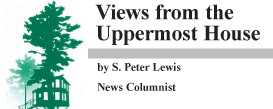Seeing through my grandmother’s hands
It’s a cold October. Crouching in the dim and dusty attic, stretching out my hands, feeling deep under the eaves blindly through the cobwebs, my fingers alight on the edge of a long-forgotten cardboard box; and into the box they creep, and there, so far from me, my fingertips touch something hard and smooth and cool, like stone, and it’s familiar — something touched long ago — and my fingers think back and remember.
on the edge of a long-forgotten cardboard box; and into the box they creep, and there, so far from me, my fingertips touch something hard and smooth and cool, like stone, and it’s familiar — something touched long ago — and my fingers think back and remember.
And I disappear.
I’m eight years old again, and it’s no longer autumn; it’s summer and I’m running barefoot down the mossy path under the soaring pines toward the boathouse that hangs out beyond the shore of the lake. Then one, two, three, up the quick steps and I burst in through the creaking door and there she is: my grandmother.
Her studio is warm and still and the low western light slants in over the water and under the boughs, and the dust motes foxtrot in the golden balsam air. The room smells of old wood and of wool and of time and of clay, always of clay, the sweet, soft, organic perfume of the clay, pulled up out of the living earth.
At the clay my grandmother the sculptor works, and the work fascinates me. Her hands fascinate me. Her fingers. I stare at them as they move. So soft and strong. Velvet stretched over iron. Pushing, pinching, forming, her fingertips following the silent directions of eyes that look through the surface of the clay, slowly revealing what she already sees beneath.
I stand transfixed in the heart of a long-ago August. I feel the gentle lake licking at the floorboards beneath my feet. Hear the slight knock of a canoe tied loosely to the dock, the distant kronk of a bullfrog. And I can’t take my eyes off my grandmother’s hands as they sweep and punctuate and encourage, as they conduct a new life into the clay.
She smiles and beckons with her eyes. “Come sit,†she says.
Then I’m up, scrambling onto the stool and my grandmother is standing behind me and we’re watching this magical thing that her hands have been making, my eyes roaming over the furrows of her imagination.
“Tell me what you see?†she asks, quietly, but I hesitate, uncertain.
Outside in the shallows among the reeds the blue damselflies flit in the sunlight, while the silver sparkle of the reflected lake dances up through cracks in the floor, glittering firelight on the wall.
“I’m not sure what I see,†I finally say.
“Close your eyes,†my grandmother tells me. Then she steps close and the folds of her smock brush against my back as she reaches her hands around my face, her fingertips alighting on my fallen eyelids as butterflies. Her skin is cool and soft and the aroma of the clay is rich in my nose, as if my grandmother were connected to the earth.
She leans in and burrows her face down through the curls of my hair and I feel the warmth of her lips against my ear. Her lips move and I hear the words, but she doesn’t just speak them; she breathes the words into me, but not only the words, but along with the words the idea behind the words: the notion that perceiving and understanding and believing is more than just seeing, and that even sight itself can found beyond our eyes. And in the next moments she changes forever the way I will look at and explore the world.
“Stretch out your hands, Peter,†she whispers. “Tell me what you see.â€

